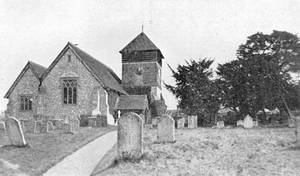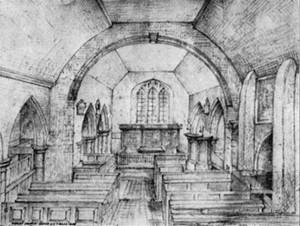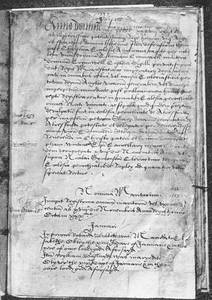The Church
St. Peter's Ropley
We are much indebted to Mr. R. C. Turner, Honorary Organist and Choirmaster of our Parish Church for nearly 40 years, for the following particulars respecting the Restoration of the Church.
Restoration Of The Church
In the year 1891 the question of the restoration of the Church was seriously considered, for it had been discovered that the building had fallen into such a state of dilapidation as to be actually insecure ; but it was not until the Rev. W. H. Leak - the newly appointed Vicar - took up his residence here in 1892 that the work was really taken in hand. Previously to this Mr. Leak had been Vicar of Bishop's Sutton, where he had undertaken the task of restoring the Church in that parish, and at the time of his appointment to the benefice of Ropley had already succeeded in raising £1,000 for the purpose.
The urgency of immediate restoration of Ropley Church was manifest to all, and at once Mr. Leak found himself surrounded by parishioners ready to help forward in every way possible a scheme of restoration. In 1894 a Restoration Committee consisting of Miss Hagen, the Rev. Canon Wynter-Gibbon, Mr. Norris, Mr. W. Barnard, and the Vicar, the Rev. W. H. Leak, was formed and an appeal made for the necessary funds.
This appeal was made directly by Mr. Leak himself and entailed the writing of at least 4,000 letters. So generous a response was made that in a very short time no less than £2,300 had been subscribed and in 1896 the work of restoration was commenced, and for over a year the usual Church Services were held Sunday by Sunday in the Day School, where the Sacraments of Holy Baptism and Holy Communion were also administered. The chief work undertaken was an entirely new roof, new East and West windows, the extension of the North Aisle to the same length as the Nave, the underpinning of the four huge oak beams supporting the tower by bases of concrete, the removal of the old gallery at the West end which provided ample accommodation for the Choir in those days, and behind them sat several of the older parishioners of the labouring class in their immaculate smock frocks. The old floor was excavated and replaced by concrete and laid with pitch pine blocks, and the high-back pews of former days gave place to chairs. It was during floor excavations in the South Transept, immediately under where the new organ now stands, that an interesting discovery was made in connection with a former casting of the Church Bells, probably at the time when "John Gilberd did contrive to cast from four this peal of five." Previous to this it was believed that the bells had been re-cast in an adjoining field but while the work of restoration was going on the workmen found in the South Transept the remains of a furnace and pieces of old bell metal which conclusively prove that it was there that the bells were re-cast. The Chancel was entirely re-arranged, the large family pews were removed and the present Choir Stalls erected in their place. The greater part of the Restoration Scheme having been completed a Service of Dedication and Thanksgiving was held on Tuesday, April 27th, 1897, when in the regretted absence of the Bishop of Winchester (Dr. Thorold) the sermon was preached by the Bishop of Guildford. It was at this service that the Village Choir first appeared in Cassocks and Surplices. Congratulating the Vicar - the Rev. W. H. Leak - on the work he had achieved the Bishop wrote :- "I greatly enjoyed the service on Tuesday and I marvel to see the Church in its present state."
The New Organ
The beautiful new Organ built by Mr. Binns, of Leeds, and dedicated by the Ven. Archdeacon of Winchester (Dr. Fearon) in March, 1911, took the place of the old harmonium, which had done duty for over 40 years.
The Church
"Ropley Church is a most interesting one," says Mr. W. G. Horseman, of Southampton, in a letter to the Rev. H. W. C. Geldart. "The nave certainly, and the chancel probably, are of exactly the same plan as in the first half of the 12th century. Of the same date is the south transept, now converted into the tower. Probably this was done late in the 14th or early in the 15th century and the South Chapel was added to the chancel late in the 13th century.
"The North Chapel and eastern part of the north aisle appear to be early 19th century work, and the western part of the south aisle was built in the restoration work of 1896.
"One regrets the removal of the old altar rails, and the position of the font almost touching the west wall of the north aisle must be most inconvenient."
August 30th, 1918
The Old Pulpit And Altar Rails
Old Stone Work
Mr. Woodhouse says : "I am told by those who can well remember it that the pulpit formerly stood in the centre of the church, supported on four posts, under which was the entrance to the pew on the left belonging to the Grove and occupied by Mr. Onslow. From there it was removed to the south side of the altar, and erected against the east wall. But it did not remain there long, and was removed again into the anomalous and inconvenient position where it still remains, under the first arch on the south side of the chancel, with the back towards the chancel aisle."
"The oak altar rails were brought from Buriton near Petersfield and cut to fit the place. The old rails before these were partly made into seats and partly left in Hale's shop."
Old Stone Work
"Fragments of the stonework of the north aisle are to be seen in many places, especially in the garden at the Vicarage. They are much broken and defaced, but enough remains to show that there was at least one Romanesque pillar with boldly moulded capital and base."
"I strongly suspect that the stone near my stable door, which is apparently intended to serve as a horse block, is part of the pedestal of the Font. In size and shape it much resembles it ; and there is a hole bored down through the inside of it, which was perhaps part of the drain."
Ropley Parish Church, The Chancel, as seen from the Old Gallery, 1896
Church Registers
The earliest entries go back to 1538, in the reign of Henry VIII., when Church Registers were first kept. The original books were rebound in 1906 by the kindness of the late Archdeacon Fearon, at his expense, and presented to the Church. This, and the next book, covering roughly the second half of the 17th century, now form two neat volumes which are a valuable relic of antiquity.
The registers as a whole are incomplete, and there are several gaps - one big one in the marriages from 1702 to 1755. From this date the entries are continuous down to the present time.
In the old days the greater number of people were illiterate, as is shown by the fact that whole pages are marked by crosses in place of signatures. Frequently both the parties married and the witnesses to their marriage were unable to sign their names.
Another interesting feature is the fact that so many Ropley names go on from generation to generation, and exist among us still. Instances are Budd, Norgate, Privett, Windebank, Passingham, Larkham, Lambourne and Hale. This shows that the love of change was less marked than it is at present.
Stone Tablet On Wall Of Ropley Church
Mr. Wm. Roughcliff
late of Sherbourne in Com Dorset
Button seller
dy'd suddenly in this parish in his
journey homeward March 4th
A.D. 1719/20 and was buried the
7th (?) under a stone
opposite inscrib'd
W.R. &c.
First Page of Church Register
The Church Bells.
These are of great interest. The original inscriptions on the five old bells are as follows :-
I as treble doo beggin S.K. 1701.
Fear God, Honnare the King S.K. 1701.
Samuel Knight mead this ring.
Robert Gatlin of London fecit 1749.
Unto this church I doo you call. Death to the grave will somans all.
John Gilberd did contrive to cast from four this peal of five (FIFE)."
In 1927 all the bells were recast by Messrs. Gillett & Johnston, of Croydon, and the original inscriptions copied. At the same time a new treble bell was added making a peal of six. This bell is inscribed :-
To the glory of God and in memory of Jacob and Mary Hagen also P.G.W., J.S.O'H. and A.H.S. The gift of M. S. Hagen, 1927.
At the same time a brass tablet was placed on the south wall of the church bearing the following inscription :
"To commemorate the gift of Marianna Sophia Hagen for the restoration of the church bells and the provision of a new treble bell. This brass is dedicated by grateful parishioners. 1927."
The notes, diameters and weights of the present bells are as follows :-
| Cwts. | Qrs. | Ibs. | |||
|---|---|---|---|---|---|
| 1 | D sharp | 28" | 4 | 2 | 6 |
| 2 | C sharp | 30" | 5 | 1 | 3 |
| 3 | B | 33" | 7 | 0 | 2 |
| 4 | A sharp | 34" | 7 | 2 | 9 |
| 5 | G sharp | 38 1/2" | 10 | 3 | 19 |
| 6 | F sharp | 43" | 15 | 0 | 23 |
| 50 | 2 | 6 |
The dedication service took place on May 31st, 1927. The ceremony was performed by the Bishop of Winchester (Dr. Woods).
The Bells
The bells peal forth across the plain,
The softly undulating hills,
The woodlands clothed in summer sheen -
Their music all the silence fills.
Long were they mute and death-like still ;
No happy bride their greeting heard,
No mourner by a new made grave
Re-echoed one sad voiceless word.
On Sabbath morns no clear-rung call
Bade us to seek our Father's face,
Believe His promise, trust His word,
And rest on His unchanging grace.
And now that they chime out once more
May their sweet music never fall
On ears unheeding, hearts grown cold,
Regardless of their gracious call.
And when the years have onward rolled,
And these frail bodies sleep in dust,
May generations still arise
For God to live, in Him to trust.
M. S. Hagen


